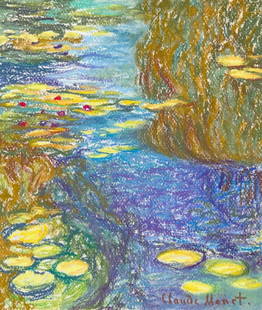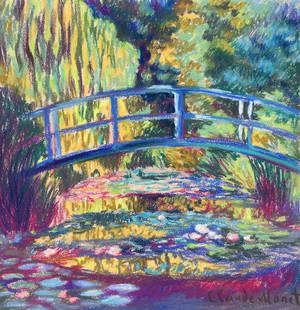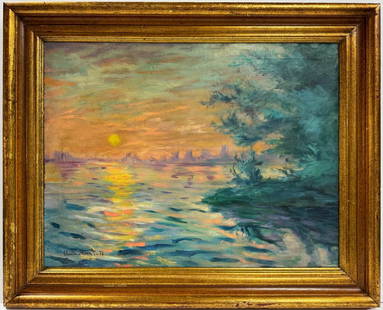
Manner of Claude Monet French (1840-1926) Tempera
Claude Monet Sale History
View Price Results for Claude Monet


Related Paintings
More Items from Claude Monet
View MoreRecommended Art
View More








Item Details
Description
Study featuring lily pads - Attributes: In the manner of Claude Monet and signed on lower left with gallery stamp on verso - Media: Tempera on paper - Dimensions metric: 25.8 by 18.3 cm - Dimensions imperial: 10 1/4 by 7 1/4 inches - Artist biography: Claude Monet is one of the most well known painters in the history of art and a top figure in the impressionist movement, his works can be seen in various museums across the world. Claude Monet grew up in Le Havre, a port town in the Normany Region and was known to be a respectful student, however, he did not enjoy being confined to the boundaries of a classroom. Monet would rather enjoy his time in the outdoors. When he was young he established a passion for drawing. Monet had schoolbooks covered in sketches of other people he drew and caricatures of his teachers. His mother supported his passion for art, although his father would have preferred him to go into business. Monet went through a severe grieving period after the death of his mother in 1857. Monet was recognized in the community for his caricatures and drawings of several town folk. When he met Eugene Boudin in 1858, he became encouraged to paint the outdoors. The outdoors or plein air painting is the foundation of Monet's work. In 1859, he moved to Paris to further pursue his art. He was influenced heavily by the paintings of the Barbizon school and enrolled as a student at the Academie Suisse. As he was studying in Paris, he met with another artist, Camille Pissaro, who was a close friend for several years. From 1861 to 1862, Monet was part of the military but was released for health reasons. He later returned to Paris and studied with Chales Gleyre. Through Gleyre, Monet was introduced to many other artists that included Auguste Renoir, Alfred Sisley and Frederic Bazille. These four artists all became friends. Monet received advice and support from Johann Barthold Jongkind, who was a landscape painter and a major influence on Monet. He loved to work outdoors and was sometimes joined by Renoir, Sisley and Bazille on these painting journeys. In 1865, Monet had two paintings of marine landscapes chosen to be displayed in the Salon of 1865, an annual juried art show in Paris. His work received critical praise, although he still experience financial difficulty. The year after, 1866, Monet was chosen again to partake in the Salon art show. The show officials selected a landscape and a portrait Camille (also known as Woman in Green) portraying his lover and future wife, Camille Doncieux. Doncieux assisted Monet by being a muse, sitting for several paintings throughout her life. In 1867, after birth of their first son Jean, Monet was in severe financial hardship and his father refused to assist. Monet became very depressed in this situation and in 1868 attempted to commit suicide by drowning in the Seine River. Luckily, Monet and Camille caught a break, after Louis-Joachim Guadibert became a patron of Monet's work. This allowed Monet to continue his art and have the proper care for his family. Monet and Camille married in June 1870, and after the Franco-Prussian War the couple fled with their son to London, England. In London, Monet met Paul Durand-Ruel, who was his first art dealer. Monet returned to France in 1872 after the war, settling in Argenteuil, an industrial town, and started his own technique. In Argenteuil, Monet visited with his art friends including Renoir, Pissarro and Edouard Manet. Manet, according to an interview, first disliked Monet as their names would often get mistaken. Monet alongside his fellow artists, helped develop the Societe Anonyme des Artistes, Peintres, Sclupteurs, Graveurs, as an substitute to the Salon and exhibited their works together. Monet would sometimes get frustrated with his work, some reports estimate that he destroyed up to 500 works. He would burn, cut or kick the piece. Alongside this frustration and anger, he would also suffer from depression and self-doubt. The society's April 1874 exhibition was revolutionary. One of Monet's most famous pieces in the show, ""Impressionism, Sunrise"" in 1873, portrayed Le Havre's harbor in the morning fog. Critics used the title of this piece to name a distinct group of artists as ""impressionists,"" noting that their work appeared to be more as sketches rather than finished paintings. Monet wanted to capture the essence of natural world using strong colours and bold, short brush strokes. He and his contemporaries avoided using blended colours and evenness of classical art. He also incorporated elements of industry into his landscapes, changing the form forward and adding making the art more contemporary. Monet started to exhibit with the Impressionists after the first show in 1874 and continued in the 1880s. Monet faced hardship in his personal life after his wife became ill during her second pregnancy and she continued to deteriorate. Monet painted a portrait showcasing her on her death bed. Before she died, the Monets started to live with Ernest and Alice Hoschede and their six children. After Camille had passed away, Monet painted a grim set of paintings called the Ice Drift series. He grew closer to Alice Hoschede and they became romantically involved. After Ernest passed away, Monet and Alice became married in 1892. Monet received financial and critical success in the late 1880s and 1890s and started the serial paintings that became very well-known. He would paint outdoors in the gardens in Giverny. The water lilies in the pond created an appeal for him and he painted several series of them throughout his life. The Japanese-style bridge over the pond resulted in the subject of many works too. In 1918, Monet donated 12 of his waterlily paintings to the nation of France to celebrate the Armistice. Monet would travel occasionally to find other sources of inspiration. He rented a room across from the Roeun Cathedral and painting a series of works based on this structure. Different paintings show in the building in the morning light, midday, gray weather and more. This repetition showcased the result of his fascination with the effects of light. In addition to the cathedral, Monet painted several landscapes and places repeatedly to showcase the sensation of a certain time of day.In 1911, Monet became depressed after the death of his beloved Alice. In 1912, he developed cataracts in his right eye. In the art world, Monet was out of step with the avant-garde. The Impressionists were in some ways being supplanted by the Cubist movement, led by Pablo Picasso and Georges Braque.But there was still a great deal of interest in Monet's work. During this period, Monet began a final series of 12 waterlily paintings commissioned by the Orangerie des Tuileries, a museum in Paris. He chose to make them on a very large scale, designed to fill the walls of a special space for the canvases in the museum; he wanted the works to serve as a ""haven of peaceful meditation,"" believing that the images would soothe the ""overworked nerves"" of visitors.His Orangerie des Tuileries project consumed much of Monet's later years. In writing to a friend, Monet stated, ""These landscapes of water and reflection have become an obsession for me. It is beyond my strength as an old man, and yet I want to render what I feel."" Monet's health proved to be an obstacle, as well. Nearly blind, with both of his eyes now seriously affected by cataracts, Monet finally consented to undergo surgery for the ailment in 1923.As he experienced in other points in his life, Monet struggled with depression in his later years. He wrote to one friend that ""Age and chagrin have worn me out. My life has been nothing but a failure, and all that's left for me to do is to destroy my paintings before I disappear."" Despite his feelings of despair, he continued working on his paintings until his final days.Monet died on December 5, 1926, at his home in Giverny. Monet once wrote, ""My only merit lies in having painted directly in front of nature, seeking to render my impressions of the most fleeting effects."" Most art historians believe that Monet accomplished much more than this: He helped change the world of painting by shaking off the conventions of the past. By dissolving forms in his works, Monet opened the door for further abstraction in art, and he is credited with influencing such later artists as Jackson Pollack, Mark Rothko and Willem de Kooning.Since 1980, Monet's Giverny home has housed the Claude Monet Foundation.
Buyer's Premium
- 22% up to $500,000.00
- 22% above $500,000.00
Manner of Claude Monet French (1840-1926) Tempera
Estimate $1,000 - $2,000
6 bidders are watching this item.
Shipping & Pickup Options
Item located in Aurora, ON, caSee Policy for Shipping
Payment

TOP














































































